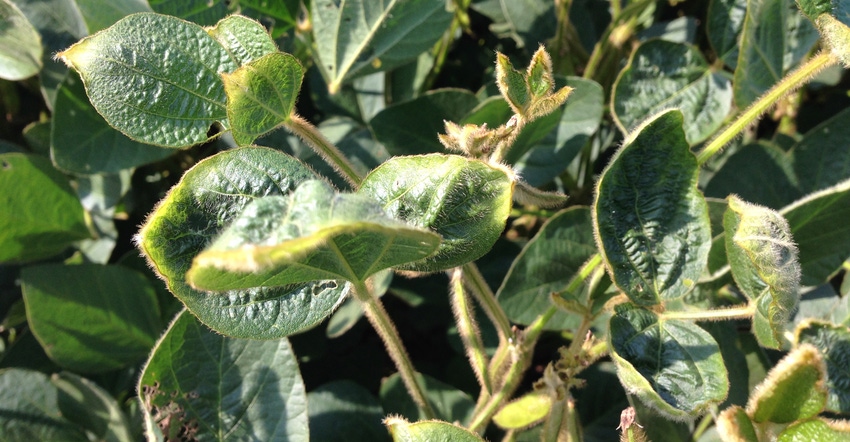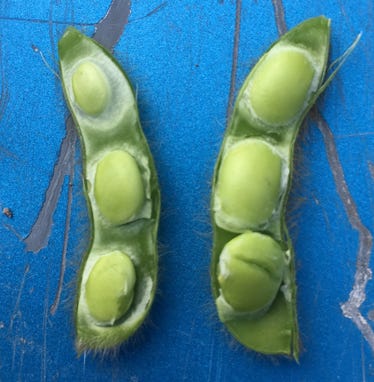
A little can go a long way for many things, right? With off-target dicamba movement, a little may go too far and cause significant damage. “Research shows as little as 0.01% contamination of dicamba can cause leaf puckering symptoms,” says Stephanie Porter, sales agronomist with Burrus Seed.
The approval of Roundup Ready 2 Xtend soybeans, Xtendimax and FeXapan herbicides with VaporGrip Technology, and Engenia herbicide open the door for later, in-season dicamba applications in soybeans. How late? XtendiMax and FeXapan can be sprayed up to R1, or the beginning of flowering. Off-target dicamba injury can do the most harm when soybean plants reach the reproductive stage. “Growth stage and concentration will determine whether or not you’ll have yield issues,” Porter notes.
 STUNTED GROWTH: Off-target dicamba applications impact new plant growth, which stunts the plant and causes it to fall behind in growth stages. Stephanie Porter, sales agronomist for Burrus Seed, shares this photo showing the height difference between healthy and affected soybean plants (left).
STUNTED GROWTH: Off-target dicamba applications impact new plant growth, which stunts the plant and causes it to fall behind in growth stages. Stephanie Porter, sales agronomist for Burrus Seed, shares this photo showing the height difference between healthy and affected soybean plants (left).

R1 is uncomfortably close to R3 through R6 growth stages, she adds, when protecting soybean plants is critical. During R3 to R6, pod and seed development begins in the soybean plant. “It could really screw things up, because that’s your time frame for your yield,” she explains. “Most of your soybean yield comes from the middle of the plant. If the middle of the plant is affected at a certain time, it could be bad.”
The application timing window for new dicamba formulations ends slightly ahead of the critical growth stages in soybeans, but neighboring nontolerant or non-GMO fields may be further along. Off-target applications could create challenges for neighboring sensitive fields if label requirements, discussed in this article, are not followed.
Signs to look for
How do you spot off–target dicamba injury? Porter shares four tell-tale signs and factors to consider:
• Puckered up. “The most common symptom is leaf puckering or crinkling,” Porter explains. Impacted leaves may “strap or narrow up” and have bumps. For soybeans further along, pods will curl under and stems may twist.
• Delayed reaction. Off-target dicamba movement symptoms will not appear for seven to 14 days, Porter notes. Farmers diagnosing injured soybeans should consider when dicamba applications were made in surrounding fields, going back more than two weeks.
• Kickback. “Dicamba impacts new growth,” Porter says. “Injury appears on the next four leaves.” The impact on new growth ultimately stunts the plant and causes it to fall behind in growth stages.
• Look-alikes. Dicamba injury can be mistaken for viruses like soybean mosaic, Porter explains, but viruses infect clusters or single plants. Dicamba-drift injuries will likely appear on the edges of fields, but ultimately the injury pattern will depend on how off target movement occurred — drift, vapor or a contaminated sprayer.
Aphids may cause leaves to pucker, but they haven’t been a challenge in recent growing seasons, Porter notes.

COMPARE AND CONTRAST: Seedfill of dicamba-stunted plants compared to healthy plants. Dicamba injury may have lingering effects in soybeans planted for seed, including emergence issues and dicamba symptoms after planting. (Photos by Burrus Seeds)
Say your crop has injury. Will it impact yield? Determining potential yield loss is next to impossible, Porter says, but the concentration of dicamba and crop stage will determine the final outcome.
To estimate potential loss, pull plants and pods from the impacted areas and compare them to pod counts from healthy plant samples.
“Ultimately, the yield monitor will tell the tale,” Porter notes.
Higher concentrations of dicamba on soybeans well into the reproductive phase are at the highest risk for yield loss.
Soybeans planted for seed affected by dicamba from R1 to R6 may produce seed with emergence issues and show dicamba symptoms after planting.
Porter adds that soybeans are at a disadvantage from the start. “Soybeans are the most sensitive plants to dicamba,” she explains.
About the Author(s)
You May Also Like




